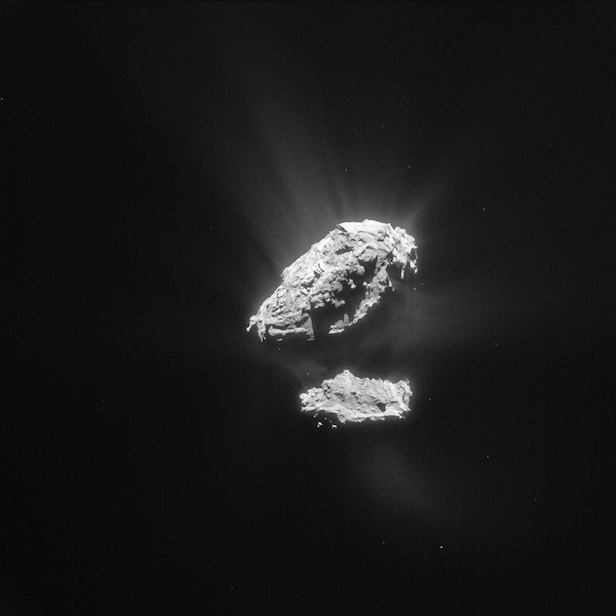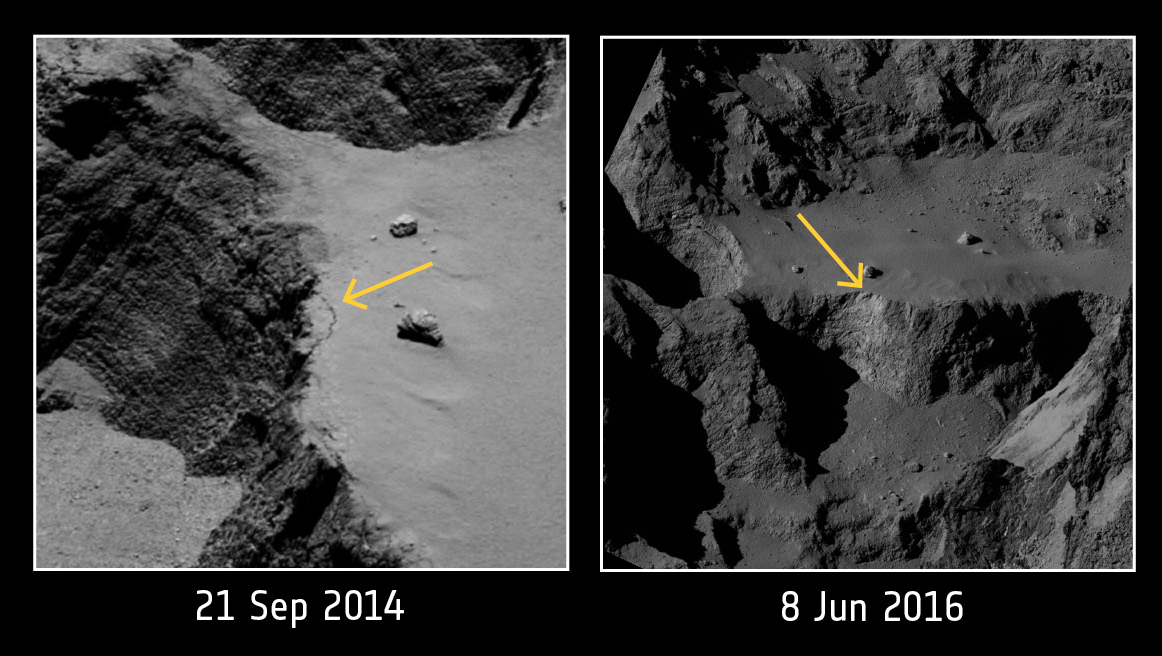Landslides and avalanches may be keeping comets active
Mass-wasting activities continuously expose fresh ice on a comet’s surface, thus keeping the comet active over long periods

The nature of how comets stay active for such long periods, such as Comet 67P/Churyumov-Gerasimenko has always eluded astronomers. Image credit: ESA/Rosetta/NavCam
The release of gases through sublimation – the term used when solids are converted directly into gases – is the defining process of comets, but a new paper by Planetary Science Institute Research Scientist Jordan K. Steckloff and Senior Scientist Nalin H. Samarasinha says that periodic landslides and avalanches, known as mass wasting, may be responsible for keeping comets active over a long time.
These escaping gases loft dust off of the comet, forming a dust cloud visible from the Earth. This gas release can even change the spin state of the comet. However, this process has long been expected to shut down as the ice present at the surface of the comet sublimates away, leaving a dust layer at the surface that insulates the remaining subsurface ice. It has therefore been unknown how comets remain active, rather than fade into non-active objects.
According to “The sublimative torques of Jupiter Family Comets and mass wasting events on their nuclei” in the journal Icarus, mass-wasting activity can excavate and expose buried ices to the surface of the comet , giving the comet fresh ice to sublimate. However, mass-wasting leads to a flattening of features on the surface of the comet over time, which in turn reduces the number and frequency of mass wasting events.
“Nalin and I independently developed our own models to study how sublimating gases that escape from a comet’s surface generate torques that change the comet’s spin state,” says Steckloff. “However, our models approached this problem from two completely different perspectives: Nalin’s model is based on Earth-based observations of comet light curves and observed gas sublimation rates. In contrast, my model considers how gases push on the surface of the comet as they escape, accounting for the effects of a comets’ activity, shape, and topography. Despite these different perspectives, these two models must necessarily be consistent with one another if they are to accurately describe the same phenomenon.”

The Rosetta spacecraft observed many mass wasting events on the surface of comet 67P/Churyumov-Gerasimenko. The arrow denotes the same location in both images, showing a crack forming behind the cliff that preceded its collapse. Mass wasting debris is clearly visible at the base of the cliff. Image credit: ESA/Rosetta/MPS for OSIRIS Team MPS/UPD/LAM/IAA/SSO/INTA/UPM/DASP/IDA
By comparing their models, Steckloff and Samarasinha found that their models can only agree with one another if these sublimative torques originate primarily from steep, mass-wasting-prone slopes. This suggests that mass wasting events such as landslides and avalanches are critical to maintaining sublimative activity on comets. This is an important result, as it was previously unknown how comets maintain their activity over many, many orbits.
Moreover, this mass-wasting process provides a mechanism for reactivating dormant comets. If spin state changes or other processes can trigger a mass-wasting event on a dormant comet, the resulting exposed ice can re-establish vigorous sublimative activity. This may explain how comets such as 2P/Encke remain active. Comet Encke took so long to evolve into its current orbit, that it should have long ago run out of ices to sublimate. This dynamical evolution timescale is 200 times longer than the sublimative timescale.
It has been proposed that Comet Encke was therefore dormant for the majority of this time, but this requires a mechanism for reactivating the comet. A large mass-wasting event may have been the mechanism that reactivated Encke into the active comet that we observe today.
“We were trying to understand how cometary activity would affect their rotation,” says Samarasinha. “In the process, we were able to explore the long-term evolution of cometary activity and conjecture how the surface layers of short-period comets might evolve. By understanding the physical processes occurring on the surfaces and in the surface layers of comets, we can provide the overall context to accurately interpret observations of comets. An in-depth understanding of comets help us ascertain the role played by these building blocks of the giant planets in the formation of the Solar System and also the various roles played by comets throughout the history of the Solar System.”
Keep up to date with the latest news in All About Space – available every month for just £4.99. Alternatively you can subscribe here for a fraction of the price!




